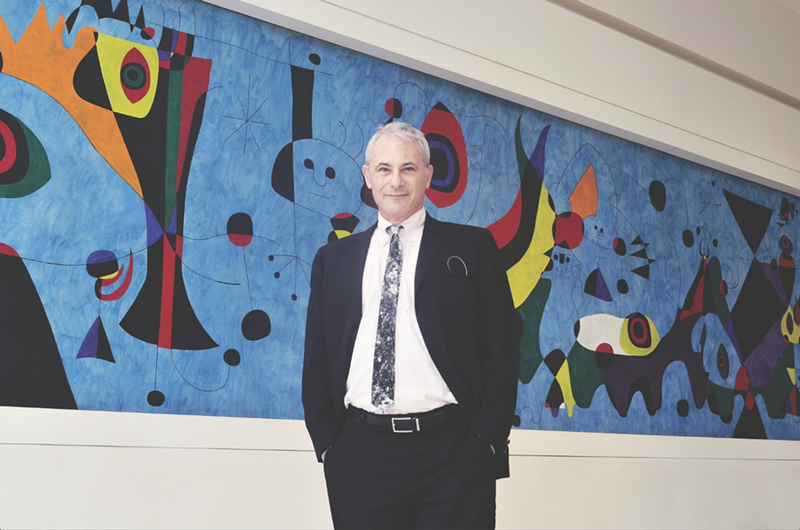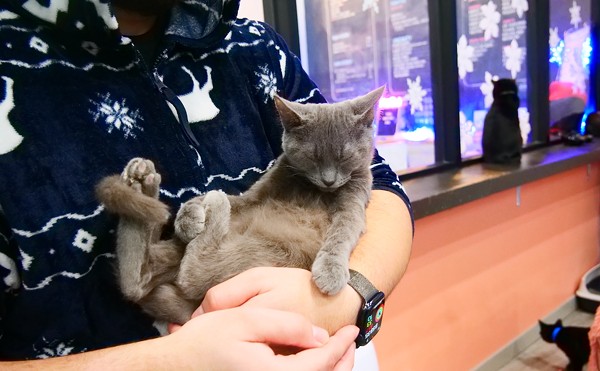M
y interview with Aaron Betsky, Cincinnati Art Museum director, came about because I was impressed by a series of small shows and changes I had noticed at CAM recently — the new Folk Art Gallery, restoration of the courtyard fountain, the reinstallation Nam June Paik’s wonderful “Powel Crosley Jr.” television sculpture in the Cincinnati Wing and more.
He wanted to talk about other positive changes coming. And the interview itself took place in a symbol of that: the glass-walled conference room in the old Art Academy of Cincinnati building that is now the museum’s administrative offices and library.
For instance, a 2015 show for the not-yet-finished Western & Southern Gallery special-exhibition space will be dedicated to Rudi Gernreich, the fashion designer who created the shocking topless bathing suit during the Swinging Sixties. Also coming in 2015 is a show featuring Old Masters from the European principality of Liechtenstein.
He also announced that the long-awaited retrospective of the late Cincinnati Pop artist Tom Wesselmann, creator of the iconic “Great American Nude” series, finally has a home for its opening next fall. It will be where the “open storage” experiment 6000 Years of Art has been.
And he revealed details for next spring’s “Crown,” the controversial piece for which artist Todd Pavlisko fired rifle shots in the museum last year. Monitors showing the filmed flight of the bullets will be set up between the masterpieces in the museum’s Icons gallery.
But, during our interview, I also brought up something else. I had recently visited the Indianapolis Museum of Art’s huge, crowded special exhibition Matisse: Life in Color and wondered (as have others) when or if such a “blockbuster” will come here. Indianapolis also has had impressive retrospectives for vital contemporary artists like China’s dissident Ai Weiwei and American “outsider” artist Thornton Dial.
Betsky was very forthright in discussing problems Cincinnati has doing such big shows. His comments should be troubling to those who care about the state of the arts here.
“One issue we still have to contend with is we’re severely underfunded and we do not have the ability that some of our peer institutions have to bring these very large-scale exhibitions to Cincinnati,” he says.
“For instance, that Ai Weiwei exhibit — we originated it. We started the discussion to bring it here. We were going to do it together with the Contemporary Arts Center. Then when Weiwei started having these problems and was put in jail, his people took it over and suddenly it became a $600,000-$700,000 exhibition and we couldn’t afford it anymore. We had to bow out.”
Essentially, Betsky says, the art museum’s budget — adjusted for inflation — has remained static while peer institutions in comparable cities have doubled or tripled theirs. Indianapolis’ endowment, he says, is four to five times the size of Cincinnati’s (which has increased by about 20 percent since 2008 and now stands at just under $86 million).
“That’s just the reality,” Betsky says. “We have to figure out what we can do well for what this community is willing to support. We just exist at a particular level that I believe is what this community is willing to support at this moment given all of its other interests and needs. So we have to figure out how to do really great things with available funds.”
“In the long run we do need to look toward some form of public support for the arts in Cincinnati,” he continues. “I know that taxes are an ugly word but I also believe the arts in general are one of things that distinguish Cincinnati, that make it — to use that overused term — unique. We have a density and quality of arts and culture that no other city in this area has and that’s one of the things that makes this city thrive. We have to support that, all of us together, or it will disappear.”
The art museum has been concentrating on what Betsky calls “node exhibits” — small or mid-sized smartly curated and beautifully installed shows that spotlight the permanent collection and/or have a strong local angles. Examples are last year’s Impressions of Venice, this year’s Eternal Summer: The Art of Edward Henry Potthast and the current Elizabeth Nourse: Rites of Passage.
This also includes very tightly focused exhibits that bring in a few major paintings from elsewhere. Next year brings Grant Wood’s “American Gothic” here from Art Institute of Chicago to hang with the museum’s own “Daughters of Revolution.” A small van Gogh show comes later.
“It’s all about creating more variety, minding our collection and addressing our community in a much more specific way,” Betsky says. “It also means redoing our permanent collection. We have a plan to rehang most of our permanent collection in stages.”
“In addition to all that, we’ll have our new education center,” he continues. “And we just received a grant to do a thorough remodeling of our front hall, which hasn’t been done in 30 years, in a way that makes it much more accessible and comfortable for people. And we also received a grant to redo our café so it will be more pleasant.”
Another surprise of the interview was learning that the museum’s attendance dropped in the fiscal year that concluded in August — to 190,478 from the previous year’s 295,661. The past fiscal year was marked by finishing up renovation of the old Art Academy and preparation for gallery changes in the museum. There were few big shows other than the FotoFocus-related Herb Ritts: L.A. Style photography exhibit.
“We had terrific attendance in the last two years — our second and third highest in history,” Betsky says. “This last year we took a step back. It had to do with our moves. And we also had to do some exhibits based on our different audiences and communities. We knew our attendance was going to be lower last year. It was lower than we hoped. Now our attendance is growing again so we certainly hope and believe it will be higher.”
If you visit the art museum, don’t be surprised to see Betsky serving as a docent. He recently completed training and is waiting for his schedule. “I know of no other museum directors who have done it,” he says. ©






